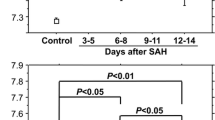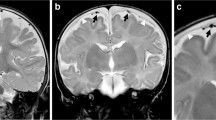Abstract
Purpose. The role of subarachnoid blood and secondary, sterile inflammation in the pathogenesis of posthemorrhagic hydrocephalus (PHH) is not well understood. The aims of this study were to study the frequency and rate of spread of blood into the spinal subarachnoid space (SSS) and to evaluate the relationship of this finding and PHH.¶Materials and methods. Nine premature babies with major intracerebral hemorrhage (ICH, grade 3 or higher), and ten premature infants with minor ICH (grade 1) or no evidence of ICH (control group) were identified and underwent serial cranial and spinal sonography at the time of initial diagnosis, 12–24 h after the ICH and weekly thereafter for at least 9 weeks. Sagittal and axial scans of the thoracolumbar spine were obtained and evaluated for the presence of echogenic debris in the dorsal SSS. Six additional patients who had cranial and spinal sonography died within the 1st week of life and underwent post-mortem examinations.¶Results. The SSS was echo-free (normal) in all cases at the time of initial sonographic diagnosis of ICH. Within 24 h, all babies with major ICH had developed increased echogenicity of the cervical and thoracic SSS. Echogenicity of the SSS decreased gradually over several weeks. Although transient ventricular dilatation was present in every patient, only one patient had rapidly progressive PHH requiring shunt placement. Transient cysts of the cervicothoracic subarachnoid space were identified in two patients 6–7 weeks after ICH. The subarachnoid space remained echo-free in all control infants At autopsy, all four infants with echogenic spinal debris had blood or blood products in the spinal subarachnoid space, whereas two infants with echo-free spinal images did not.¶Conclusions. Spread of blood from the ventricular system into the spinal subarachnoid space after ICH is common and can be seen within 24 h of initial ICH. Subarachnoid blood is associated with post-hemorrhagic ventricular dilatation and transient spinal subarachnoid cyst formation.
Similar content being viewed by others
Author information
Authors and Affiliations
Additional information
Received: 18 April 2000/Accepted: 15 August 2000
Rights and permissions
About this article
Cite this article
Rudas, G., Varga, E., Méder, Û. et al. Changes in echogenicity of spinal subarachnoid space associated with intracranial hemorrhage: new observations. Pediatric Radiology 30, 739–742 (2000). https://doi.org/10.1007/s002470000336
Issue Date:
DOI: https://doi.org/10.1007/s002470000336




